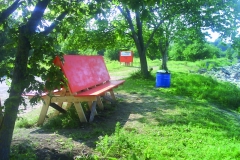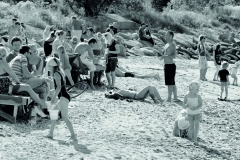Liina Siib (LS): You and I first came to Kalarand (a coastal area in Tallinn, literally ‘fishing beach’, close to the old town) in 2005, during the Trichtlinnburg project, when you organised a walk around Kalamaja along the railway. Together with Teele Pehk and Triin Talk, you produced an installation here during the 2011 Capital of Culture programme.
Toomas Paaver (TP): Indeed, this place offers wonderful opportunities.
LS: If you remember, in 2005 we admired and picked up pebbles there, the result of industrial construction. The sea had smoothed and cast the stones to the shore.
TP: It’s the same place and similar lovely peb- bles can still be picked up there. The railway has been replaced by the Culture Kilometre. Some people, of course, regard it as nothing more than a dusty road, but it has definitely opened up the seaside area and encourages people to come here.
LS: Don’t you feel that when the railway rails were removed, something essentially characteristic of the Kalamaja residential area disappeared?
TP: I do, a bit, but it was really difficult to walk along the railway. It would have been best if the Culture Kilometre project could have somehow creatively used the rails as well. However, the track itself and the atmosphere have survived and the design tries to stress that. Unfortunately, the city officials consider the Kilometre only temporary. They want a road for cars instead. A small road is probably necessary, but this could run along the Kilometre, zigzag, if necessary, which looks friendlier anyway.
LS: What was the access to the sea like in 19th century Tallinn? People walked from Old Town along Pikk Street – and then what?
TP: The 19th century coastline was where the Culture Kilometre is now. Pikk Street smoothly led to Suur-Patarei Street. This con- nection is currently broken by a confusing traffic juncture. Kalarand has been down here since ancient times; old photographs show numerous boats. Some pictures also depict bathing houses. The closure of the area was a Soviet phenomenon. Reopening the town to the sea should mean that everybody can go to Kalarand, to swim and take boats out.
LS: The detail plans, however, allow the developer to build many closely placed buildings in the area near the water, and even take more land from the sea. The shore will once again be cut off.
TP: The most unpleasant part of the new planning is the filling of the shore with soil, making it straight as a ruler, and pushing it towards the sea. It will give more land to the developer. In my opinion, it is idiotic and a waste of money to build a promenade into the sea and just give away the seashore, especially as we essentially already have a cosy promenade. The plans were produced dur- ing the boom craze, along with an endless bureaucratic procedure, and nobody seems to know how to turn it all back. The Tallinn City Planning Department wants to proceed with the same plan. Those who decide, and even the developers, seem to realise that it is hopelessly misguided, but they are unable to do anything about it, at least for now.
LS: Pro Kapital’s development plan smells of gated communities. The inhabitants of the planned new urban area will have much better access to the sea than others.
TP: This planning indeed looks like that, where a gated community could reach the sea. The harbour in the plan looks suspicious too, as if only the boats of that community would land there. Other townspeople would have to stay away. The harbour is, in fact, not necessary at all and even the developer is not that interested. So it appears that the situation is even worse: abandoning the harbour means that the present Kalarand will survive, but will then find itself in the middle of a residential plot of 400 flats. The roads and the plots seem to be intentionally placed in a way that makes public access very difficult.
LS: How are Tallinn’s seaside areas actually developed? What happens when one part belongs to the state, another part to the town and a third part is privately owned? Does the state have a say at all? Or is it mainly Tallinn that makes the decisions?
TP: The town’s will has been weak. The state, on the whole, has the state’s interests at heart, for example the mining harbour for the navy. Or tries to sell something. The land under the streets still largely belongs to the state, but it is gradually being given to the town, gratis. If Tallinn wants to be a serious maritime town, the centre should definitely have a seaside park, but there is no land for that. The sur- roundings of Kalarand would be ideal, but through the land reform it all went into private ownership. The chances that the town will buy it back seem utopian. A few dozen metres of seaside for the promenade probably means a deal with the owner, who is then allowed to build his development nearby. At the moment, there is not even a desire to proceed.
LS: The state and the town do not often cooperate?
TP: Do they both feel that they have the duty to look after people’s need for space and create diverse public space? Perhaps they occasionally do, although they seem to focus on the popular idea of how to raise money from space.
LS: What about involving the community? They use this space.
TP: If you expressed the idea in any city office that we could develop public space on this plot of land, the typical reply would be: who is going to build it, who can afford it, and who will keep it tidy? No, no, better sell it to some- one. Less bother all around. This is the usual attitude. The town architect, for example, can- not do anything he wants either, because he does not control the purse strings. Kalarand is a bit different, because excellent space already exists here; it simply must be protected and everything is in fact fine without spending any money. Protection and development of public space should be the joint aim of both the state and the town.
LS: Considering Kalarand, which is a matter between the town and the developers, can’t the state interfere at all?
TP: The state, i.e. the Harju County governor, can supervise the planning. The governor represents the state. This is an opportunity for the state, although in most cases the verdict of the supervisors is that all is correct legally. In the case of Kalarand, we should keep in mind that the development wants to go straight into the sea, but the sea belongs to the state. In that sense, the state is an owner. But, again, who, which department, deals with this?
LS: What government department actually owns the sea in the Republic of Estonia?
TP: The sea is an exceptional case; it cannot be registered or divided into plots. The sea and bigger lakes are luckily parts of our country that cannot really be bought or sold. Every other public space is not protected by law, so a stupid city government can, in fact, sell off the entire street network. This cannot happen with the sea, although there are exceptions here too. The owner of a seaside plot of land can apply to expand the land at the expense of the sea. Here the decisions are made by the Technical Surveillance Authority. As far as I know, the topic of cosy public spaces is not included in decision-making. We desperately need an office or something, in both the town and the state structure, that could systematically deal with questions of public space.
LS: Of all the seaside area, Tallinn only owns the City Hall, the territory for the new Town Hall and the Culture Cauldron. Is the rest of the seaside territory under private ownership?
TP: This happened in the course of our land reform and for other reasons. We all live in the world of private ownership, but this means that we have to set restrictions on pri- vate owners. Ideally, the seaside area of his- torical Kalamaja, the railway and the Culture Kilometre should be a wide area with pub- lic buildings, such as the City Hall, Patarei (Battery) Prison, and the seaplane hangars – this is a totally different space. It could be very pretty if the buildings were close to the sea, but Kalarand is not the place.
LS: Last summer, you tried to develop a ‘self-emerging beach’ in Kalarand. Nobody from ‘higher up’ offered this beach to the people of Kalamaja; people just occupied the empty area for their own beach. Just like the Contemporary Art Museum of Estonia CAME, which a few years ago established a museum and an exhibition space in an abandoned house.
TP: We did initially have this plan to emphasise the beach potential of this area, until it was taken for granted. Pro Kapital did not ban it, although the land belongs to them. They could not, in fact, have banned it, because the beach
was taken over by people a long time ago and is located on a legally open shore path. People have squatted in state-owned abandoned houses before, and brought them to life. It is wonderful that the old power plant is now the Culture Cauldron and the The Museum of Contemporary Art of Estonia is taken seri- ously. If only the decision-makers would start thinking, the same would happen in Kalarand. In ten years time, nobody will understand why the planning being pushed ahead now was allowed in the first place. On 12 June 2011 we threw a party on Kalarand – people who had never been there before could not believe that such a place existed, and could not believe that there was a plan to destroy it.
LS: How many people did you have at the party?
TP: A few hundred. It will be clear this spring whether the beach undertakings can become a tradition. The Telliskivi Society is already hatching a plot to restore the wooden sun- bathing platforms which have vanished from the beach, and also to organise refuse collection in summer. The cabin for changing clothes is there. It is orange and can be seen from afar. A bench seems to be still there too. You can see them from the boat coming from Helsinki, two sparkling objects.
LS: Is the water clean at Kalarand?
TP: Tests say that there are no dangerous bacteria. There is a water purification plant on Paljassaare Peninsula, and refuse is no longer dumped into the sea. The industrial waste at the bottom of the sea (concrete, bricks, asphalt and glass) has been smoothed by the sea, hence the colourful pebbles on the shore. The water gets deep very quickly and the water exchange is good. Nobody has been harmed by the water in any way.
LS: To what extent do the people living in the area and using the space have a say in the development of this place?
TP: This right must be claimed, on the peo- ple’s own initiative. Squatting is one means. After all, the current owners sort of squatted on this beach, shrewdly privatising it during the land reform. Both sides now regard the beach as their own and so there is fierce fight- ing about the planning. The planning should not lean too strongly towards one side, but should be something of a social agreement.
Toomas Paaver (1976), MA at the Estonian Academy of Arts in architecture and urban planning. Between 2003 and 2007 he worked as Kuressaare town architect, in 2009–2010 as an adviser in the planning department at the Ministry of Internal Affairs, then at his own enterprises Linnalahendused (Urban Solutions) and Paik Architects. Since 2010 has been dealing with associating civil society and urban planning, mainly through the Telliskivi Society. See more at www.paik.ee






